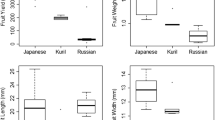Abstract
Variation in the relationship among cane and cluster characteristics in Thompson Seedless and its mutants, Tas-A-Ganesh and 2A, was assessed with an aim to (a) identify the basis for variations, (b) determine the optimum levels of the attributes of yield and quality, and (c) suggest the means to improve the desired attributes in the three clones of grapes. Variation in the number of clusters/cane, the number of berries, rachis length and brix yield per cluster was highest in 2A, while the brix yield/cane was highest in Thompson Seedless. Pearson correlation coefficients indicated significant variations between the clones in respect of cane diameter, buds broken/cane, brix yield/cluster, clusters/cane, berries/cluster, berry diameter and rachis length/cluster. Multiple linear regression equations involving cane diameter, buds broken/cane, clusters/cane, rachis length/cluster, berries/cluster, berry diameter and cluster compactness could explain the variation in brix yield/cluster to be 69.0, 71.4 and 44.1%, in Thompson Seedless, Tas-A-Ganesh and 2A clones respectively. Cluster compactness had more contribution towards brix yield/cluster in 2A, while cane diameter and the number of broken buds/cane contributed more in Tas-A-Ganesh. Cluster compactness in turn was determined to be 94.9, 80.5 and 32.6%, in Thompson Seedless, Tas-A-Ganesh and clones respectively, by cane diameter, uniformity in bud break, uniformity in flowering rachis length (cm)/cluster, berries/cluster, berry diameter (mm) and clusters/cane together in a multiple regression analysis. These investigations revealed the scope to increase the brix yield/cluster in Thompson Seedless by increasing the total rachis length and retain a larger number of berries/cluster; increase the fruitfulness of buds and removal of unfruitful shoots after forward pruning to increase the brix yield/cane in Tas-A-Ganesh and to elongate the clusters and reduce the number of berries to produce loose to well-filled clusters; and increase the berry diameter in 2A.



Similar content being viewed by others
References
Alleweldt G (1959) Die wirking der gibberellinsaure auf einjahrige Reben bei Verschiedener photoperiode. Vitis 2:23–33 (German)
Loomis NH, Lutz JM (1937) The relationship of leaf area and leaf area fruit ratios to composition and flavor of Concord grapes. Proc Am Soc Hortic Sci 35:46–50
NHB Indian Horticulture Database—2014. Ministry of Agriculture, Government of India
Shikhamany SD (1983) Effect of time and different doses of N and K on growth, yield and quality of Thompson seedless grapes (Vitis vinifera L.). Ph.D. thesis, University of Agricultural Sciences, Bangalore, India
Shikhamany SD, Reddy NN (1992) Response of Thompson seedless grape to paclobutrazol under mild tropical conditions. In: Proceedings of international symposium on recent advances in viticulture and oenology, Hyderabad, India pp 163–72
Srinivasan C, Mullins MG (1981) Physiology of flowering in the grapevine—a review. Am J Enol Vitic 32:47–63
Turner JN (1972) Practical use of gibberellin in agriculture and horticulture. Outlook Agric 1:14–20
Winkler AJ (1930) The relationship of number of leaves to size and quality of table grapes. Proc Am Soc Hortic Sci 27:158–160
APEDA Export Import Data Bank Version 7.2-Tradestat. Ministry of Commerce and Industries, Government of India
Acknowledgements
The authors are grateful to the office bearers and the Chairman, Central Research Committee of the Maharashtra State Grape Growers’ Association, Pune, for supporting these studies. Also, thanks are due to S/Shri. Suresh Kalamkar (Mohadi village), Arun More (Pimpalgaon village), Ashokrao Gaikwad (Palkhed village), Jagannathrao Khapre (Kothure village) and Manikrao Patil (Khedgaon village) for facilitating these studies in their vineyards. The support given by Prof. T.S. Mungare and Shri. T.S. Shelke and the guidance provided by the Research Advisory Committee of the Association and by Dr. Venugopalan, Principal Scientist, Agricultural Statistics, ICAR—Indian Institute of Horticultural Research, Bengaluru, are gratefully acknowledged.
Author information
Authors and Affiliations
Corresponding author
Rights and permissions
About this article
Cite this article
Shikhamany, S.D., Borade, S.V., Jeughale, S.K. et al. Variation in the Relationship Among the Cane and Cluster Characters in Thompson Seedless Grape and Its Mutants. Agric Res 7, 251–264 (2018). https://doi.org/10.1007/s40003-018-0296-8
Received:
Accepted:
Published:
Issue Date:
DOI: https://doi.org/10.1007/s40003-018-0296-8




